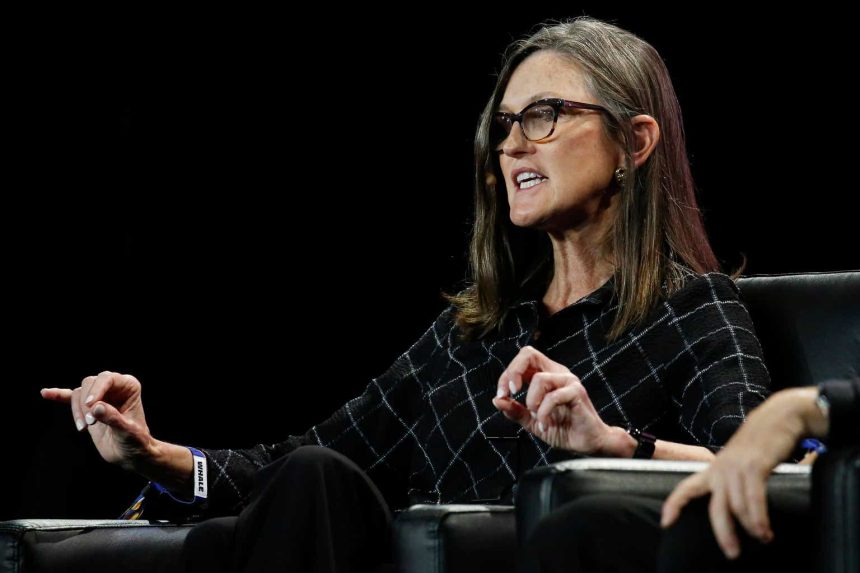ARK Genomic Revolution ETF (BATS:ARKG) is an actively managed fund with a sharp focus on genomic innovation. It seeks to drive long-term capital growth through strategic investments in a diverse range of sectors: healthcare, information technology, materials, energy, and consumer discretionary. Key investment technologies include CRISPR, targeted therapeutics, bioinformatics, molecular diagnostics, stem cells, and agricultural biology.
This report aims to meticulously examine the ARKG fund’s trading activities. We spotlight trends in individual holdings, assessing their potential to significantly influence the ETF’s performance. A critical aspect of this analysis is gaining insights into the fund management team’s decision-making processes.
Investor Advisory: For informed investment decisions, thorough consultation of the detailed ARKG fund information is recommended. Access comprehensive data and insights here: https://ark-funds.com/
Top Holdings
At September 30th of 2023, the ARKG fund is constituted by the following holdings:
ARK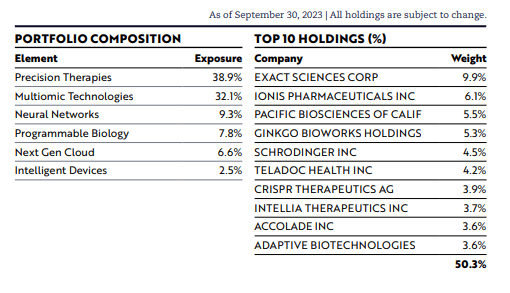
The fund’s portfolio reveals a notable concentration, with its top 10 holdings representing about half of its total value, a slight decline from 54% in the previous quarter. This concentration is evidenced by the stability of its largest investments: Exact Sciences remains the leading holding, while Ionis Pharmaceuticals has risen to second place, followed by PacBio and Ginkgo. Although there’s been some reshuffling within the top 10, no new entries or exits were observed, indicating a period of relative stability in the fund’s key investments.
Buying activity
Now, let’s turn our attention to the buying activity. In the last quarter, the fund’s managers bought stocks amounting to over 4% of the fund’s total value. This buying spree was particularly focused on four stocks: Recursion (RXRX), Moderna (MRNA), Pacific Biosciences (PACB), Adaptive Biotechnologies (ADPT).
Author’s computations based on company filings
These four stocks accounted for half of the fund’s buying activity, offering insightful glimpses into the fund’s strategy. Pacific Biosciences, holding 5.5% of the fund’s portfolio, is a prominent investment, suggesting strong confidence in its growth prospects. Adaptive Biotechnologies, with a 3.6% portfolio share, sits comfortably in the fund’s upper-middle tier, continuing the trend from the previous quarter.
Recursion Pharmaceuticals, though not yet in the top 10, emerged as a key player. It’s a relatively smaller position compared to PACB and ADPT but has witnessed the most significant investment from the fund in the third quarter. This increase in investment, especially following a stock price slide, underscores the fund’s strong conviction in Recursion’s potential. For a deeper analysis of Recursion’s position and prospects, further detailed information is available here.
Author’s computations based on company filings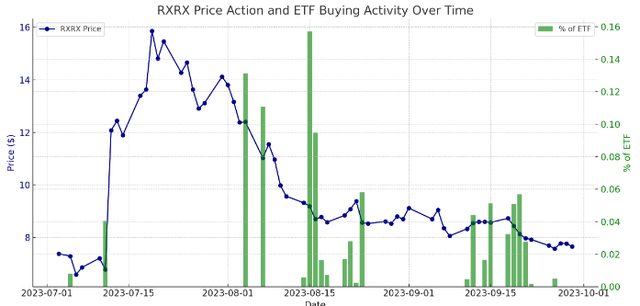
Moderna, while a smaller holding in comparison to the other three stocks discussed, presents a unique case. This quarter, the fund’s considerable investments in Moderna marked it as the second-largest acquisition, a move that appears more about strategic positioning rather than high conviction.
Author’s computations based on company filings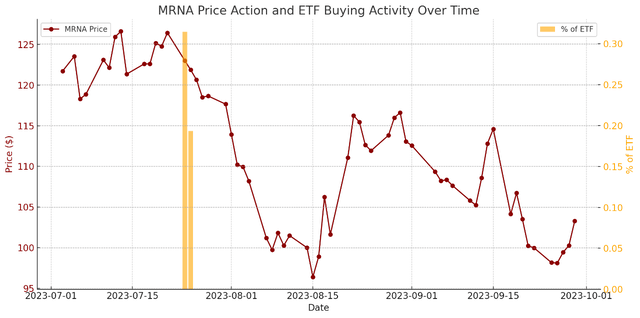
In contrast, Pacific Biosciences stands out as one of the fund’s most confident picks. The recent launch of its Revio sequencing platform, with promising initial results, has only strengthened this position. My detailed analysis on PacBio, available elsewhere, delves deeper into this. The fund’s strategy of increasing its stake in Pacific Biosciences as prices dropped aligns with ARKG’s typical approach.
Author’s computations based on company filings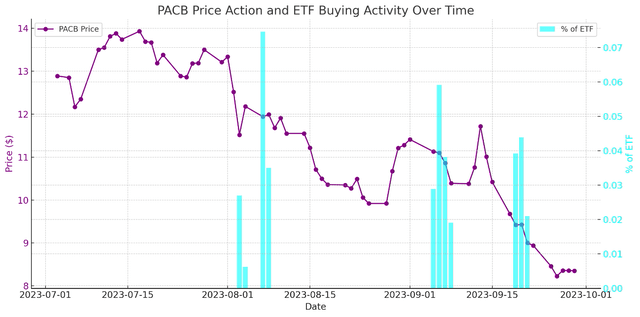
Adaptive, the fourth largest acquisition this quarter, also followed the pattern of buying on dips, elevating it to a top 10 holding in the fund.
Author’s computations based on company filings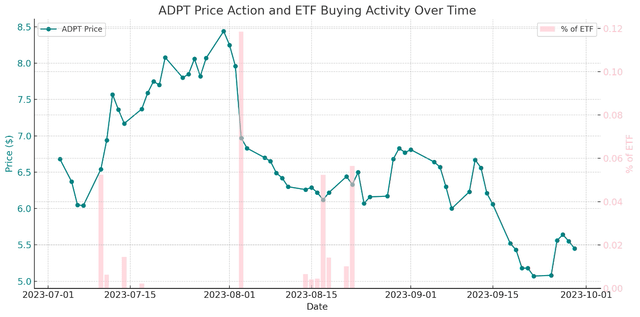
Overall, the purchases of Recursion and Pacific Biosciences are particularly noteworthy. These stocks have been long-term additions to the fund, and their recent developments have only heightened their significance in the portfolio. Interested investors should keep monitoring them.
Selling Activity
During the last quarter, the fund engaged in significant selling activity, notably reducing holdings of Schrodinger (SDGR), Nvidia (NVDA), Exact Sciences (EXAS) and Codexis (CDXS).
Author’s computations based on company filings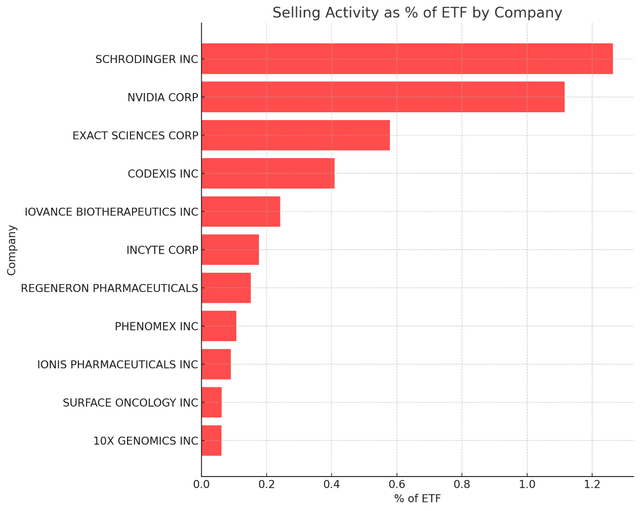
Schrodinger, despite being the largest sell-off, remains within the fund’s top ten holdings. This suggests that the sale was driven more by the stock’s appreciation rather than a diminished belief in the company’s prospects. The fund often adopts this strategy, as indicated by the accompanying chart. However, the scale of selling implies a moderate conviction in Schrodinger, especially when compared to the ARK’s tendency to maintain high conviction stocks at around 10% of the portfolio.
Author’s computations based on company filings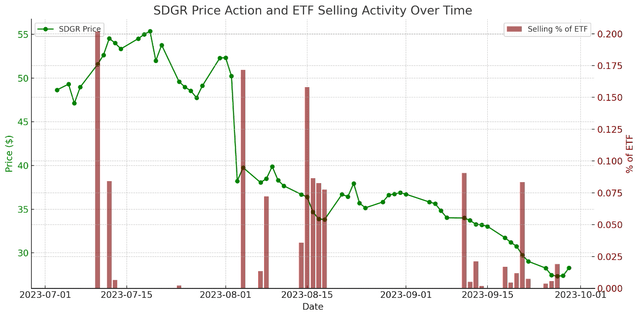
Nvidia’s sale was the second-largest. Cathie Wood’s previous remarks about Nvidia not being the fund’s preferred choice for AI chips, particularly given its current valuation, provides context for the substantial sell-off during this quarter’s bullish market. This aligns with the fund’s strategic approach to portfolio management, adapting to market valuations and performance trends.
Author’s computations based on company filings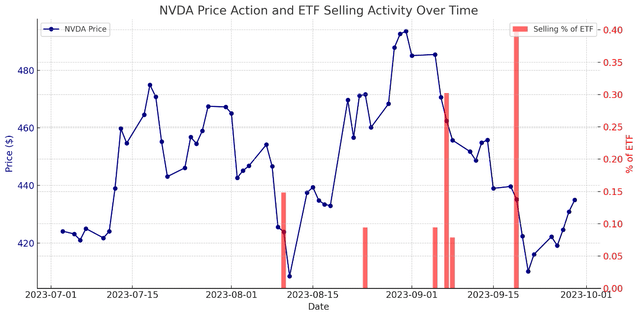
Exact Sciences mirrored Schrodinger’s selling pattern, yet the fund maintained its remaining stake close to 10%. This strategy suggests a strong conviction in Exact Sciences, an inference supported by my detailed analysis of the stock available elsewhere.
Author’s computations based on company filings
Codexis, however, stands out as an exception. Unlike the others, it was sold during a period of weakness, potentially indicating a decrease in confidence in the company. As of this writing, Codexis is no longer part of the fund’s portfolio, further emphasizing this shift in sentiment. This divergence in approach highlights the fund’s dynamic investment strategy.
Author’s computations based on company filings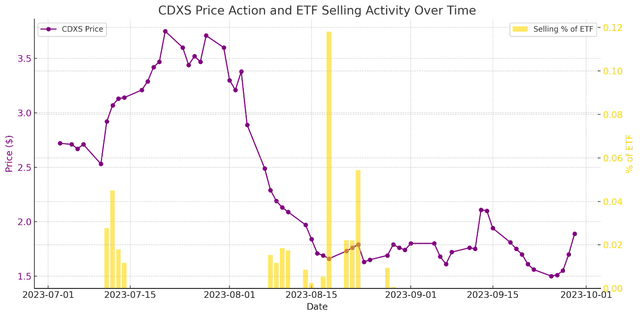
Main conclusions for ARKG
After reviewing the fund’s second-quarter activity, eight companies emerge as key players: Adaptive, Recursion, Moderna, PacBio, Nvidia, Exact Sciences, Codexis, and Schrodinger. PacBio and Recursion are highlighted as strong conviction buys, made during price weaknesses, indicating a firm belief in their potential. Schrodinger’s sale appears tactical, capitalizing on strength to reallocate resources, while the sale of Exact Sciences seems more like a minor adjustment rather than a strategic shift.
However, it’s important to consider the fund’s context within the market. ARKG stands out for its relatively high management fees compared to its peers.
Seeking Alpha
Despite this, it’s a billion-dollar fund that has not only experienced periods of notable outperformance but is also currently leading its sector year-to-date.
Seeking Alpha
In my view, the fund’s future performance is likely to be heavily influenced by its top 10 holdings. Its strategy of selling well-performing stocks and buying during price dips draws attention to the companies it invests in with the proceeds from these sales. The extensive list of third-quarter purchases warrants closer scrutiny, especially Recursion, a consistent buy, and PacBio, a sequencing equipment provider that has seen success in new product launches. The sales list also offers insights, particularly the decision to maintain a significant stake in Exact Sciences and the reduced investment in Schrodinger, indicating varying degrees of conviction in these stocks.
Finally, analyzing the risks associated with this ETF reveals some crucial considerations. A significant portion of the fund’s holdings are in early-stage companies, many of which are yet to generate revenue. This situation is comparable to the uncertainty of gardening, where some seeds will thrive, while others might not develop at all.
These early-stage companies are often characterized by high cash burn rates, necessitating further capital infusion, likely through share issuance. This introduces two key risks: dilution and liquidity. Dilution happens when new shares are issued, potentially diminishing the value of existing shares. On the other hand, liquidity risk becomes a concern if the companies struggle to secure the necessary funds, which could jeopardize their ability to fulfill short-term financial obligations.
For investors considering this fund, it is essential to understand and weigh these risks. The potential for significant growth in early-stage companies is counterbalanced by the inherent uncertainties and financial challenges they may face.
Read the full article here


